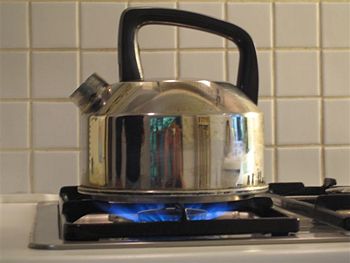Heat: Difference between revisions
imported>Paul Wormer No edit summary |
imported>Paul Wormer No edit summary |
||
| Line 1: | Line 1: | ||
{{subpages}} | {{subpages}} | ||
{{Image|Kettle.JPG|right|350px|Heat of gas flame is transferred to water in kettle }} | |||
'''Heat''' is a form of [[energy]] that is transferred between two bodies that are in thermal contact and have different [[temperatures]]. (For instance, the bodies may be two compartments of a vessel separated by a heat-conducting wall and containing a liquid of different temperature on either side of the wall.) Heat flows spontaneously from a higher-temperature to a lower-temperature body. The effect of this transfer of energy usually, but not always, is an increase in the temperature of the colder body and a decrease in the temperature of the hotter body. | '''Heat''' is a form of [[energy]] that is transferred between two bodies that are in thermal contact and have different [[temperatures]]. (For instance, the bodies may be two compartments of a vessel separated by a heat-conducting wall and containing a liquid of different temperature on either side of the wall.) Heat flows spontaneously from a higher-temperature to a lower-temperature body. The effect of this transfer of energy usually, but not always, is an increase in the temperature of the colder body and a decrease in the temperature of the hotter body. | ||
Revision as of 01:23, 16 June 2009
Heat is a form of energy that is transferred between two bodies that are in thermal contact and have different temperatures. (For instance, the bodies may be two compartments of a vessel separated by a heat-conducting wall and containing a liquid of different temperature on either side of the wall.) Heat flows spontaneously from a higher-temperature to a lower-temperature body. The effect of this transfer of energy usually, but not always, is an increase in the temperature of the colder body and a decrease in the temperature of the hotter body.
A vessel containing a fluid may lose or gain energy without a change in temperature when the fluid changes from one aggregation state to another. For instance, a gas condensing to a liquid does this at a certain fixed temperature (the boiling point of the liquid) and releases condensation energy. When a vessel, containing a condensing gas, loses heat to a colder body, then, as long as there is vapor present in the hotter vessel, the temperature of the container remains constant at the boiling point of the liquid, even though it loses heat to the colder body. In a similar way, when the colder body is a vessel containing a melting solid, its temperature will remain constant while it is receiving heat from a hotter body, as long as not all solid has been molten. Only after all of the solid has been molten and the heat transport continues, the temperature of the colder body (containing only liquid) will rise.
The important distinction between heat and temperature (heat being a form of energy and temperature a measure of the amount of that energy present in a body) was clarified by Count Rumford, James Prescott Joule, Julius Robert Mayer, Rudolf Clausius, and others during the late 18th and 19th centuries. Also it became clear by the work of these men that heat is not an invisible and weightless fluid, named caloric, but a form of motion. The molecules of the hotter body are (on the average) in more rapid motion than those of the colder body. The first law of thermodynamics, discovered around the middle of the 19th century, states that the (flow of) heat is a transfer of internal energy. In the case of ideal gases, internal energy consists only of kinetic energy and it is indeed only this motional energy that is transferred when heat is exchanged between two containers with ideal gases. In the case of non-ideal gases, liquids and solids, internal energy also contains the averaged inter-particle potential energy (attraction and repulsion between molecules), which depends on temperature. So, for non-ideal gases, liquids and solids, also potential energy is transferred when heat transfer occurs.
The actual transport of heat may proceed by electromagnetic radiation (as an example one may think of an electric heater where usually heat is transferred to its surroundings by infrared radiation, or of a microwave oven where heat is given off to food by microwaves), conduction (for instance through a metal wall; metals conduct heat by the aid of their almost free electrons), and convection (for instance by air flow or water circulation).
If the two bodies exchanging heat are separated from the rest of the universe (i.e., no other heat flows than between the two bodies and no work is performed on them) then the entropy of the total system increases upon the spontaneous flow of heat. This is a consequence of the second law of thermodynamics that states that spontaneous thermodynamic processes are associated with entropy increase. In this case the increase is easy to compute when we recall that the entropy S of a system at absolute temperature T increases with:
when it receives an amount of heat ΔQ. The hotter system (2) loses heat and the colder system (1) gains it and in absolute value the quantities of heat are the same by the conservation of energy, hence
Here we assume that the exchange of heat is so small that the temperatures of the two bodies do not change. One can achieve this by considering a small time interval and/or very large heat reservoirs.


